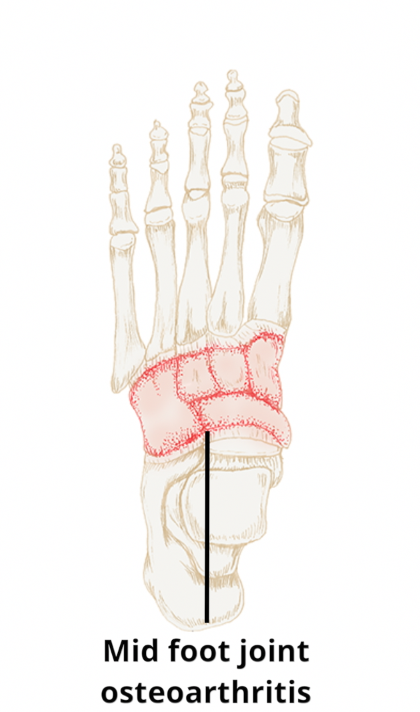
Osteoarthritis of the midfoot is the name given to arthritis which gives pain in the joints spanning the arch of the foot. This also causes the foot to become stiff.
The process of osteoarthritis involves wearing or thinning of the smooth cartilage joint surfaces as well as stiffening to the soft tissue surrounding the joints. Swelling, inflammation and pain are potential consequences.
Several factors normally combine to cause symptoms of osteoarthritis:
- Previous joint damage (from trauma or other conditions such as gout and rheumatoid arthritis)
- Increased bodyweight
- Age (risk increases with age)
- Family history (genetics)
- Poor ankle-foot alignment (termed biomechanics) such as a flat foot posture
General exercise such as walking, cycling and playing sport does not increase the risk of developing or increase the rate of deterioration of, midfoot osteoarthritis.
How is midfoot osteoarthritis treated?
Non-surgical management
In the majority of cases, symptoms of midfoot osteoarthritis can be managed effectively by non-invasive measures as described below.
Footwear. The most effective measure is wearing the appropriate footwear including boots or shoes with adequate support around the ankle and under the arch of the foot.
Orthotics. Insoles that offer support under the arch of the foot can be effective at reducing pain.
Exercises. Regular exercises can be used to maintain strength to the affected ankle and foot.
Using painkillers when needed. Over-the-counter analgesia is available through pharmacies when needed. Unfortunately, there is little evidence to back their effectiveness although they are commonly used and prescribed. Paracetamol is most commonly prescribed. Anti-inflammatories, such as Ibuprofen, are also used, but as there is little or no inflammation involved in osteoarthritis these are best avoided without discussing with your GP. Side effects are even more common than with paracetamol so please ensure to take appropriate medical advice.
There is a good booklet on the Versus Arthritis website with information about the various drug options.
https://www.versusarthritis.org/about-arthritis/treatments/drugs/painkillers-and-nsaids/
Corticosteroid injection therapy. For individuals with midfoot osteoarthritis who continue to suffer disabling symptoms in spite of a course of non-surgical management, a corticosteroid injection can be offered as the next line of treatment. This injection will usually be performed under ultrasound guidance to ensure correct needle placement. You can read more about local corticosteroid injections here. This injection aims to offer short to medium-term pain relief.
Surgical Management
Midfoot joint fusion can be offered, which totally limits any available movement in the midfoot. Limiting this movement means that fusion operations are an effective operation for pain but may cause problems with certain activities and can potentially cause arthritis to develop in adjacent joints which have to compensate for the movement lost. Midfoot fusions will, therefore, only be considered as a last resort for patients with advanced osteoarthritis, who:
-
- Have trialled a course of non-surgical management without success
-
- Have consistent, disabling pain significantly limiting mobility
-
- Have a satisfactory Body Mass Index (BMI) or have made lifestyle changes to lose excess bodyweight
Unlike many joints with advanced osteoarthritis, there is no option to perform a joint replacement for the midfoot joints. It is also worth noting that the period of rehabilitation after surgery is approximately 6 months for satisfactory resolution of symptoms.